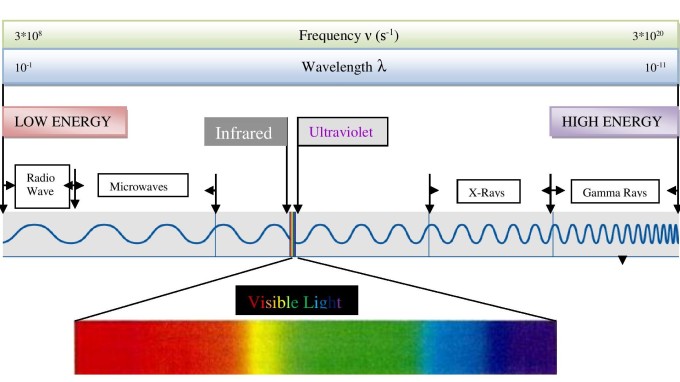(Originally published at The Technical Lens, republished on The Information Station with prior permission of the author and site owner.)
What? Night Vision v Thermal Vision
Birds of Prey, wild cats, chameleon, spiders, and dragon flies have outstanding night vision. What is night vision? Basically, it is when an optical receiver detects infrared radiation bouncing off or emitted from the surface of an object. In animals, the optical receiver is organic located within the rods and cones behind eyes and nerves attached to the central nervous system. Humans have generally poor night vision and can only see visible light. Visible light, like the colors of a rainbow, share an Electromagnetic (EM) frequency between ~3.9*1014Hz – 7.5*1014Hz where 1Hz = one full cycle per second. Infrared Radiation (IR) frequencies vary between ~0.003*1014Hz – 4.00*1014Hz. Like visible light, IR rest together within the EM Spectrum where energy is transferred as particle (photons) waves at various wavelengths. When energy is released from between differing potential, photons are released and can be measured. While many animals have more sensitive mechanisms to detect and process IR, humans do not. So we need an artificial method of amplifying the energy.
So this brings us to the next question. What is the difference between vision and imaging? The simple answer is animals have vision and technology has enhanced imaging. A crucial point to keep in mind: ‘vision’ as it relates to technological product descriptions is not really vision, it is enhanced imaging. You are probably thinking ‘I thought this article was about Thermal Vision’. You are correct, but first, we had to delineate between vision and imaging. Next, we can specify what Thermal Vision is.
Click HERE1 for more information on Human Vision.
All matter emits energy as IR from the motion of particles at temperatures above absolute-zero. Thermal Infrared Radiation(TIR) is the physical form, often felt as heat, of IR. Since IR is invisible to the human eye, but can be felt as heat, sensitive technologies can measure the intensity of it. In fact, heat is transferred in one of three methods; IR, conduction, and convection respectively. Therefore, technologies have been developed to measure the varying intensities of TIR which can be displayed visually on a screen or heads-up-display (HUD). Where Night Vision technologies measure and display reflected IR signatures, often as hues of greens and yellows, Thermal Vision measures TIR emissions from a surface of a body and displays the results as respective colors of visible light.
How? Sensors and Imaging
IR has a longer wavelength than visible light and thus is lower energy and safer to work with. Briefly, night vision technology uses IR light emitting diode (LED) illuminators to shine IR light behind the imaging receiver. The light hits an object, bounces back, and is collected and processed via electronic integrated circuits electrodes and silicone substrates which convert the signature into electrical current. The electrical current is then analyzed by a central processor and converted into an image. Night vision technologies amplify the existing and or received IR emitted light.

(Image by R. Kaeru)
At the core process, Thermal Vision works very much the same way with the exception of the technologies involved. TIR is dependent upon the Spectral Range, or IR frequency wavelength, relationship to the intensity of the waveform. Application of TIR is best used as a sensing mechanism. An example of a rudimentary thermal sensor is a bolometer. A bolometer is a telescope with centralized thermistor, or a temperature-sensitive resistor which produces detectible voltage. A more definitive sensor is the Complimentary Metal-Oxide Semi-Conductors (CMOS) A matrix of pixels with individual transistors to amplify single output. CMOS is unique because each pixel can be measured individually. Although they are more susceptible to noise interference and lower quality than Charged-Couple Devices, however, they are more cost effective. A Charge-Couple Device (CCD) “is an integrated circuit etched onto a silicon surface forming light sensitive elements called pixels.” The pixels are arranged into a matrix consisting of rows and columns with an open register row and Output Node at its end. They work by collecting photon energy, like a bucket would catch rain water, then one column of energy is transferred to the open register row which transfers the total energy to the end output node. The next column (still full of energy) transfers into the recently dumped first column. The result is a cascade effect of energy transfer from one column to the other to a collection register and a final output node. This method is a very sensitive and efficient analog-to-digital conversion in registering energy transfer on a display. The CCD technology is ideal for goggles, scopes, or hand-held devices because they can be made very small. These are high quality sensors with less susceptibility to noise interference.
Accurate temperature measurements are produced when combining CCD TIR sensor technologies with imaging software. The resulting image will displayed as a visible light spectrum where hotter surfaces will present as whites and reds; whereas, cooler surfaces will present blues and violets. The practical advantages of Thermal Vision applications are many. One innovative product is just hitting the market using Smartphone and SEEK XR Thermal Sensor technology.
Ultimately, thanks to the particle physicists studying quantum mechanics of particles, we have better understanding of what IR is. This knowledge, of course, paves the way to development of measuring instruments to identify, quantify, and visually represent the emitted radiation. The research and development of applicable Thermal Imaging products for the consumer will continue to evolve. Quantitative innovations such as visual built-in imaging, automated functionality, and software are producing more efficient, cost effective, and more portable Thermal Vision solutions.
Reference:
1) Delgado-Bonal, Alfonso, and Javier Martín-Torres. 2016. “Human vision is determined based on information theory.” Scientific Reports 6, 36038. MEDLINE Complete, EBSCOhost http://www.nature.com/articles/srep36038 (accessed November 26, 2016).
No comments:
Post a Comment